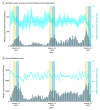Comparison of Estimated Effectiveness of Case-Based and Population-Based Interventions on COVID-19 Containment in Taiwan
- PMID: 33821922
- PMCID: PMC8025126
- DOI: 10.1001/jamainternmed.2021.1644
Comparison of Estimated Effectiveness of Case-Based and Population-Based Interventions on COVID-19 Containment in Taiwan
Abstract
Importance: Taiwan is one of the few countries with initial success in COVID-19 control without strict lockdown or school closure. The reasons remain to be fully elucidated.
Objective: To compare and evaluate the effectiveness of case-based (including contact tracing and quarantine) and population-based (including social distancing and facial masking) interventions for COVID-19 in Taiwan.
Design, setting, and participants: This comparative effectiveness study used a stochastic branching process model using COVID-19 epidemic data from Taiwan, an island nation of 23.6 million people, with no locally acquired cases of COVID-19 reported for 253 days between April and December 2020.
Main outcomes and measures: Effective reproduction number of COVID-19 cases (the number of secondary cases generated by 1 primary case) and the probability of outbreak extinction (0 new cases within 20 generations). For model development and calibration, an estimation of the incubation period (interval from exposure to symptom onset), serial interval (time between symptom onset in an infector-infectee pair), and the statistical distribution of the number of any subsequent infections generated by 1 primary case was calculated.
Results: This study analyzed data from 158 confirmed COVID-19 cases (median age, 45 years; interquartile range, 25-55 years; 84 men [53%]). An estimated 55% (95% credible interval [CrI], 41%-68%) of transmission events occurred during the presymptomatic stage. In our estimated analysis, case detection, contact tracing, and 14-day quarantine of close contacts (regardless of symptoms) was estimated to decrease the reproduction number from the counterfactual value of 2.50 to 1.53 (95% CrI, 1.50-1.57), which would not be sufficient for epidemic control, which requires a value of less than 1. In our estimated analysis, voluntary population-based interventions, if used alone, were estimated to have reduced the reproduction number to 1.30 (95% CrI, 1.03-1.58). Combined case-based and population-based interventions were estimated to reduce the reproduction number to below unity (0.85; 95% CrI, 0.78-0.89). Results were similar for additional analyses with influenza data and sensitivity analyses.
Conclusions and relevance: In this comparative effectiveness research study, the combination of case-based and population-based interventions (with wide adherence) may explain the success of COVID-19 control in Taiwan in 2020. Either category of interventions alone would have been insufficient, even in a country with an effective public health system and comprehensive contact tracing program. Mitigating the COVID-19 pandemic requires the collaborative effort of public health professionals and the general public.
Conflict of interest statement
Figures




Comment in
-
Lessons From the Success of COVID-19 Control in Taiwan.JAMA Intern Med. 2021 Jul 1;181(7):922. doi: 10.1001/jamainternmed.2021.1625. JAMA Intern Med. 2021. PMID: 33821884 No abstract available.
References
-
- Davies NG, Kucharski AJ, Eggo RM, Gimma A, Edmunds WJ; Centre for the Mathematical Modelling of Infectious Diseases COVID-19 working group . Effects of non-pharmaceutical interventions on COVID-19 cases, deaths, and demand for hospital services in the UK: a modelling study. Lancet Public Health. 2020;5(7):e375-e385. doi:10.1016/S2468-2667(20)30133-X - DOI - PMC - PubMed
Publication types
MeSH terms
Grants and funding
LinkOut - more resources
Full Text Sources
Other Literature Sources
Medical
Miscellaneous

